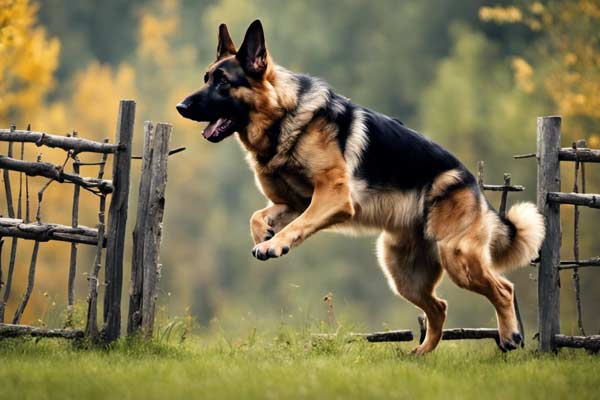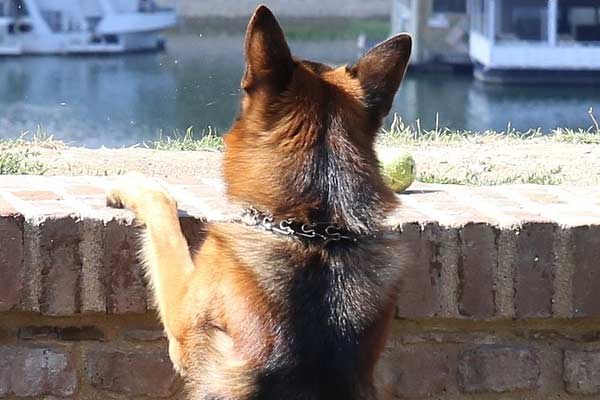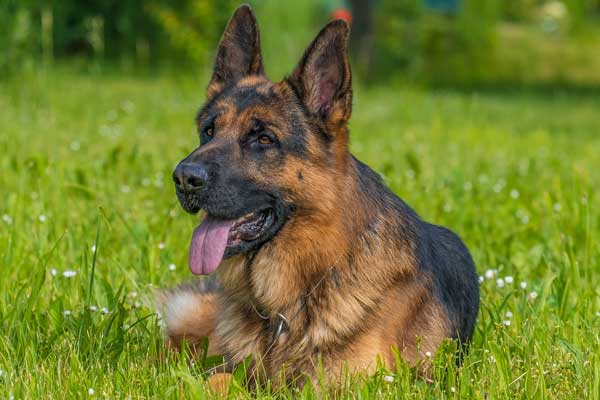How High Can a German Shepherd Jump: Understanding Their Impressive Athletic Abilities
German Shepherds are renowned for their smartness, devotion, and physical strength, with jumping a prominent example of their athletic skills.
Many people wonder how high a German Shepherd can jump; the answer is that they can quickly jump as high as 4 to 6 feet. Given a long enough run-up, they can reach much greater heights.
Additionally, GSDs can be trained for high jumps, given their build, athleticism, and drive.
With their athletic build and strong hind legs, German Shepherds can jump exceptionally high, surpassing many other dog breeds. Training can enhance their ability to leap even higher, especially with a running start.
Their outstanding athleticism and agility make them a preferred breed for various canine sports, excelling in vertical and horizontal jumps due to their robust nature.
On average, a German Shepherd can jump about 10 to 15 feet horizontally in a single bound.
According to Yahoo, the highest a German Shepherd has ever jumped is nearly 10 feet high. This incredible feat was performed by a two-year-old dog named Hei Niu in Ningbo City in eastern China’s Zhejiang Province on March 10th.
However, it’s important to note that not all German Shepherds can jump this high, and it’s not recommended to train your dog to jump to such heights as it can be dangerous for their health. Understanding the limits of your dog’s jumping ability is vital to keep them safe and healthy.
German Shepherd Basics
German Shepherds, originating from Germany in the late 1800s, were first bred as working dogs due to their intelligence, strength, and loyalty, making them perfect for herding, guarding, and police duties. Nowadays, they are favored family pets, renowned for their protective nature and loving demeanor.
German Shepherds are medium to large dogs. Males usually weigh 65-90 pounds, while females weigh 50-70 pounds. They are muscular and have solid hindquarters and deep chests, enabling efficient running and jumping.
The German Shepherd usually has a black and tan coat, but it can also be sable, black, or white. They possess a dense, double coat that shields them from the weather and experience moderate shedding all year round.
German Shepherds are known for their trainability, which is perfect for families looking for a manageable pet. Their loyalty and protective instincts also qualify them as great family dogs.
However, they need substantial exercise and mental engagement to remain content and healthy. Regular walks, play sessions, and training are essential for their physical and mental well-being.
If not provided with adequate activity, German Shepherds may become restless and exhibit destructive behaviors, hence the importance of ensuring ample play and exploration opportunities.
Jumping Ability and Factors
German Shepherds are known for athleticism and rear solid legs, enabling them to leap great heights. Nonetheless, various physical and psychological elements can influence their ability to jump.
Physical Abilities
The physical abilities of a German Shepherd play a significant role in their jumping ability. A healthy adult GSD can jump as high as 4 to 6 feet, with a long enough run-up to reach even greater heights.
Their muscular hind legs provide the necessary power to propel them into the air, while their physical fitness and condition also play a role in their ability to jump.
Age and physical condition can affect a German Shepherd’s jumping ability. As they age, their strength and agility in the muscles and joints may diminish, decreasing their jumping ability.
Additionally, GSDs that are overweight or have joint problems may struggle to jump as high as their healthier counterparts.
Mental Factors
Mental factors also play a role in a German Shepherd’s jumping ability. These dogs are brilliant and require mental stimulation to motivate them. With proper mental stimulation, they may become bored and gain interest in jumping or other activities.
Training and motivation are also essential factors in a GSD’s jumping ability.
Positive reinforcement is critical in this process, as it encourages the dog to continue jumping and provides motivation to improve.
Training for Jumping
German Shepherds are known for their athleticism and powerful hind legs, allowing them to jump higher than most dog breeds. However, training is still necessary to develop their jumping skills.
Basic Training
Basic training is crucial for all types of dog training, including jumping. Ensure your German Shepherd has mastered obedience training before teaching them to jump. They should respond reliably to commands like sit, stay, come, and heel.
Once your German Shepherd is obedient, you can teach them to jump over obstacles such as a broomstick or a low fence. Start with a low obstacle and gradually increase the height as your dog becomes more comfortable. Use positive reinforcement during this training, such as treats or praise, to motivate your dog.
When teaching your German Shepherd to jump, it’s essential to use a firm voice and be consistent with your commands. For example, use the same command whenever you want your dog to jump, such as “jump” or “over.” This will help your dog understand what you want them to do.
Agility Training
Agility training is an excellent method to enhance the jumping abilities of your German Shepherd, involving guiding your dog through a course filled with obstacles like jumps, tunnels, and weave poles.
It’s a delightful bonding activity and a source of mental and physical engagement, refining your dog’s coordination, balance, and speed.
Register your German Shepherd in an agility class or create your course home. Positive reinforcement is crucial during training, rewarding your dog for good behavior.
Keeping your dog motivated and ensuring they enjoy the experience is vital, making agility training fun and rewarding.
Health and Jumping
Jumping can be an excellent way for German Shepherds to exercise and release energy, but it is essential to consider their health when training them to jump. German Shepherds are susceptible to specific health issues affecting their jumping ability, such as arthritis and hip dysplasia.
Arthritis is prevalent in older dogs, leading to joint pain and stiffness challenging jumping and movement.
German Shepherds are particularly prone to arthritis, so monitoring their joints and limiting their jumping is crucial if they show signs of pain or discomfort.
Age is another factor to consider when it comes to jumping. As dogs age, their joints and muscles may not be as strong as they once were, making jumping more difficult and painful. It is essential to adjust training accordingly and not push older dogs too hard when jumping.
Finally, hip dysplasia is a hereditary condition impacting the hip joint, leading to pain and movement issues. It’s crucial to be mindful of this, especially when training German Shepherds to jump, as they are among the most susceptible breeds.
Jumping and Fences
German Shepherds, renowned for their athleticism and strong hind legs, can jump higher than many other dog breeds. This jumping ability can make containment challenging for owners wishing to keep their dogs in their yards. Consequently, a suitable fence is essential to prevent German Shepherds from escaping.
Regarding fences, there are different materials and designs to choose from. Chain link fences are popular but may not be the best choice for German Shepherds because they can easily climb or jump over them. Solid panel fences, on the other hand, can be an effective solution as they provide a physical barrier that is difficult to overcome.
For German Shepherds, who can jump up to 6 feet, a fence of at least 6 feet is advised. If your dog is incredibly agile, consider a 7-foot fence. An alternative is an invisible fence, but it might not deter determined German Shepherds due to their high pain tolerance.
Jumping in Work and Sports
German Shepherds are known for their jumping ability, which is why they are often used in police, military work, and canine sports.
Police and Military Work
German Shepherds are commonly used in police and military work due to their intelligence, agility, and strength. Their jumping ability is beneficial in these jobs, as they can quickly jump over obstacles and barriers during pursuit or search and rescue missions.
German Shepherds assist police in tracking and capturing suspects and detecting drugs and explosives. They also serve as guide dogs for those with visual impairments.
German Shepherds are used in the military for various tasks, including detecting mines and explosives and search and rescue missions.
Canine Sports
German Shepherds’ jumping ability also makes them popular in canine sports. In dock diving, German Shepherds compete to see who can jump the farthest off a dock into a pool of water. In air retrieve, they jump to catch a toy suspended. They also excel in distance jumps, jumping as far as they can from standing.
German Shepherds are proficient in jumping and excel in agility courses, easily navigating through obstacles like tunnels, jumps, and weave poles. They are also adept at tracking and can follow scent trails to locate hidden objects or people.
Behavior and Jumping
German Shepherds, recognized for their athletic ability and strong back legs, can jump higher than many other dog breeds. Factors like boredom, anxiety, and aggression can impact this jumping behavior, altering its frequency and intensity.
When a German Shepherd is bored, it might jump a lot to burn off excess energy. This can be troublesome if it results in damage or harm.
Therefore, providing them with enough physical and mental stimulation is essential to keep them engaged and entertained.
When German Shepherds experience anxiety, it can lead to them exhibiting jumping behavior, attempting to escape or climb over fences or barriers when feeling stressed or overwhelmed.
This behavior poses risks as they might injure themselves or others. Thus, resolving the root of their anxiety and ensuring a safe, secure environment is essential.
German Shepherds are known for their protective nature and may jump to protect their owners or other dogs from perceived threats. While this behavior can be admirable, it can also be dangerous if it leads to aggression or territorial behavior. Therefore, training them to obey commands and socialize with other dogs and people from an early age is essential.
Notable Jumping German Shepherds
German Shepherds are known for their impressive jumping abilities, and some individuals have set records for their feats of athleticism. Here are a few notable jumping German Shepherds:
- Guinness World Record Holder – A German Shepherd named “Cinderella May” holds the Guinness World Record for the highest jump by a dog, clearing a bar set at 6 feet 6 inches (1.98 meters) in 2006. This incredible achievement showcases the breed’s power and athleticism.
- Hei Niu – In China, a German Shepherd named “Hei Niu” gained fame for his ability to jump over a 6-foot wall to escape his owner’s yard. He became a local celebrity and even appeared on a Chinese television show. While not officially measured, his jumps were estimated to be around 6 feet.
- Belgian Malinois Comparison – While German Shepherds are impressive jumpers, they are not the only breed with this ability. Belgian Malinois, another working breed, are also known for their jumping skills. However, a study comparing the two breeds found that German Shepherds could jump higher than Belgian Malinois, with an average jump height of 5 feet 9 inches compared to 4 feet 11 inches for the Malinois.










